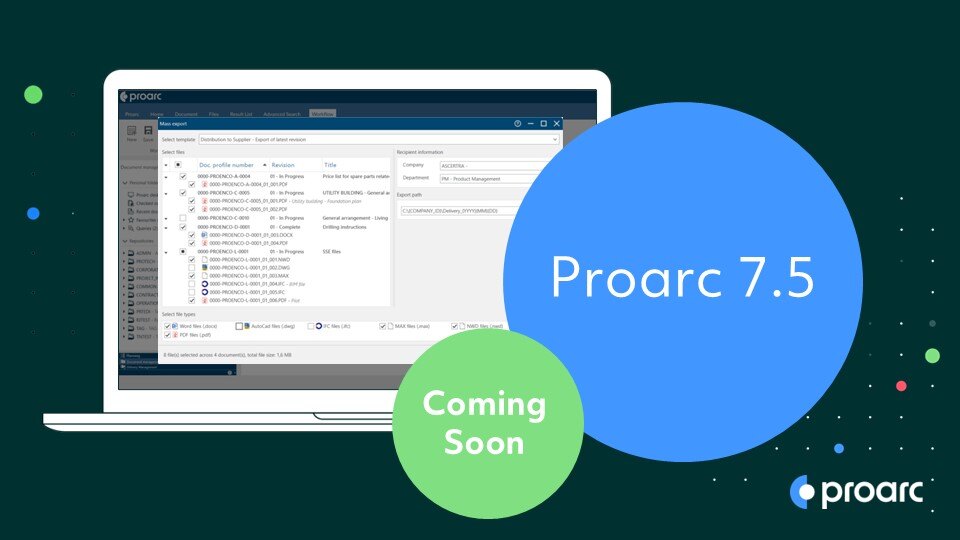
Interface Management 101
What is Interface Management?
At a high level, interface management is the process of managing complex interface dependencies between contracting parties, delivery teams, and even internal business units. Interface management is performed in a structured, accountable manner through information sharing, collaboration, and stewardship. Although it may sound simple, depending on the size of your engineering and construction project, interface management can quickly become overwhelming without the right processes and tools in place.
"Effective Interface Management [IM] is integral to project success. It is defined as the appropriate management of communications, relationships, and deliverables among two or more interface stakeholders."
-PMI (Project Management Institute)
The more contractors, subcontractors, vendors, suppliers, and internal delivery teams, the greater the opportunity for miscommunication (or lack of communication) and conflicts. In the same vein, the more interfaces you have, the harder it is to keep the project within scope, on schedule, and within your budget.
Interface management is a framework that formalizes communications and collaboration at interfaces and includes people, processes, and tools. All of these work together to mitigate the risk created by complex interfaces and resulting interdependencies.
Interface management programs reduce or eliminate disconnects during engineering and construction, where most interface issues are identified and discovered. A critical element to achieving this goal is through the alignment of the project team on the importance of an Interface Management Program and its early implementation. Once the program is established, all interactions between contractors related to interfaces can be managed and carefully coordinated to avoid misunderstandings and lack of information. Predictability in managing interfaces is increased and decisions can be made quicker and with more clarity and certainty.
Related Content
What is an Interface?
Essential to understanding interface management is understanding what an interface is itself. Interfaces occur at project points where scope boundaries between different contracting parties intersect. They define the scope of work under a contractor's responsibility which may influence or be influenced by the scope of work covered by another contractor working on another part of the overall project at large.
Although there is often no official contractual obligation between the contracting parties who share interfaces, each party must deliver their scope to seamlessly integrate with the other party’s scope to construct the overall asset successfully. Missing or incorrectly defined interfaces are often a major cause of cost overruns, engineering variations, claims, and system/product failures.
Most of the time, interface management deals with the physical interfaces, but can also include regulatory and environmental interfaces.
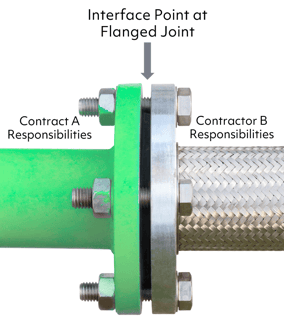
Figure 1: An example of an interface
In addition, interfaces can be categorized as either internal or external. Internal interfaces are within a scope of work while external interfaces are between scopes of work and can also include tie-ins to existing assets or facilities. Both types of interfaces play a crucial role in ensuring project success.
Why Interface Management
(Hint: To Reduce Risk!)
Interface management is a risk mitigation tool used to formally align interfacing parties, raise awareness of interface issues, and keep teams aligned.
Interface management helps project teams:
- Improve the predictability of managing interfaces,
- Improve alignment between interface parties, and
- Reduce project risks, issues, and conflicts.
Interface management achieves this by providing a common framework for identifying interfaces, eliminating ambiguity on roles and responsibilities, and facilitating the necessary communication and collaboration related to these project interfaces. As capital projects grow in scope and complexity, there is increasing demand to control interface-related issues and costs.
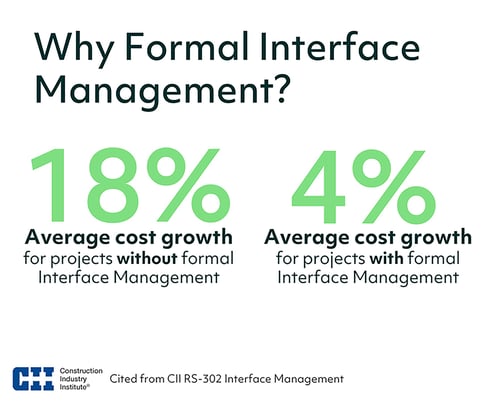
Does your Project Need Interface Management?
Interface Management Benefits
Ultimately, interface management helps projects reduce cost and schedule growth related to interface issues.
Interface management achieves these higher-level business goals by providing project teams with tools that help to:
- Reduce ambiguity on roles and responsibilities
- Formalize alignment between scopes of work
- Increase transparency and accountability
- Reveal early indications of potential problems
- Integrate interfaces with a schedule to ensure alignment
Related Content – Minimize Cost Growth with Interface Management
"Interface Management is a project management and systems engineering management discipline applied to address the risk associated with project interfaces and the interactions they require - both internal to the project and between external entities influencing the project."
-Michael Bible and Susan Bivins, Project Interface Management - Reducing Risk on Major Projects
Interface Management & Stakeholder Benefits
Let’s dig a little deeper into the key benefits of interface management. Projects that implement and execute a solid interface management program will reap many rewards, including reducing delays and rework, eliminating ambiguity at interfaces, improved project team efficiency, and interface risk mitigation supported by a comprehensive audit trail of all activity. All this adds to better management of the project schedule and cost growth.
We understand the benefits to the overall project, but what are some of the ongoing benefits for individual stakeholders? Understanding and communicating the value to each stakeholder is critical to achieving buy-in, adoption, and ensuring that project teams realize the total value and potential of their interface management program. Here is a short list of the top benefits interface management provides key project stakeholders.
Contractors
As a contractor, you will receive the following benefits from interface management (supported by interface management software):
- Precise requirements and timely responses to requests from your interfacing parties
- Formal alignment on technical fields that help reduce errors/rework and ensure milestones are met and you receive payment!
- Competitive advantage for contractors with interface management experience
- Flexible reporting to accommodate different clients
- Meet contract incentives through on-time and early deliveries
- Greater clarity/confidence in scope delineation
Owners:
As an owner, you will receive the following benefits from interface management (supported by interface management software):
- Deliver more successful projects
- Improved scope delineation that helps to improve the accuracy of bids and reduces change orders
- Compliance to interface management procedures across contractors
- Reduced cost overruns and schedule delays
- Reduced discovery costs and resolution to disputes faster
Project Management Teams:
As a project management team, you will receive the following benefits from interface management (supported by interface management software):
- Early visibility into potential interface issues and conflict
- Ability to identify and focus on high-risk interfaces
- Ability to track, report, share, and manage interface progress
- Ability to monitor scope change
- Ability to ensure on-time interface deliverables
Related Content –
- Mitigate Integration Issues Across Scopes of Work
- Defining Contractor Scope of Work at Project Interfaces
Mitigating Risk with Interface Management Key Performance Indicators (KPIs)
As with any major project, you’re likely worried about what could go wrong. What are the risks you should be prepared for when it comes to interface management, and how do you avoid them? What does success look like? How do you measure the ongoing “health” of your interface program?
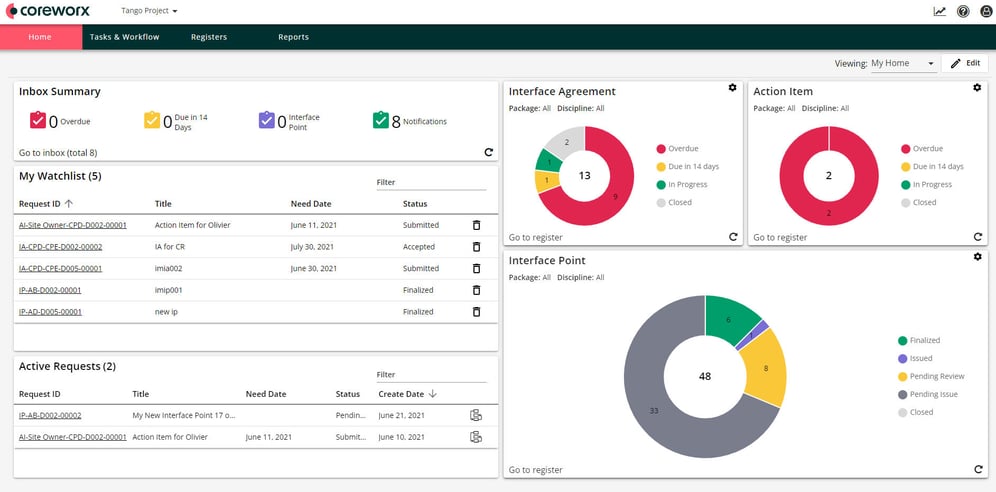
Key Performance Indicators (KPIs) provide invaluable insights that help teams measure and manage complex capital projects through each project lifecycle phase to successful completion. What many may not know, however, is the depth of insight projects can obtain from the KPIs produced through their interface management program. Let’s look at some of the critical risk management insights that interface management can provide project teams.
-
Risk: Scope Change
KPIs used to monitor scope change are potential indicators of pending change orders.
-
Risk: Contractor Disconnects
KPIs within Interface Connect can help identify disconnects between contractors or if they are communicating effectively.
-
Risk: Schedule Discrepancies
Another primary risk that a purpose-built interface management system can help mitigate is interface-related delays impacting the project schedule.
Learn more about KPIs:
Interface Management KPIs – Leverage Your Data for Insights
Planning & Implementation
Now that we’ve defined what interface management is and the many benefits it provides projects, let’s take a closer look at what it takes to plan and implement a solid interface management program.
Interface Management and the Project Life Cycle
As with most project disciplines, starting early has proven to provide the best results. Your interface management program should be established at the start of your project, during front end planning ideally, and continue throughout operations. The establishment of this level of practice early on sets the foundation for success throughout the entire project cycle.
Front end planning is the process of developing sufficient information and defining the scope for a project, allowing for the selection of a preferred solution moving forward. A contracting strategy is chosen for the project after identifying scope, interface dependencies, and risk; all of which contribute to the complexity of the project. Starting your interface management program during front end planning sets the basis for ensuring clarity in bid packages and provides a deeper understanding of project interfaces as stakeholders join the project.
Although many view interface management as a project discipline applied during specific project phases, IM is proven to provide value throughout the duration of the project and into asset management. Some interface activities are completed during early planning, while others are executed across the project lifecycle. The following provides a few vital interface activities that happen in each project phase.
|
|
|
|
Any changes to interface information or dates will have a cascading effect during any phase and must be managed effectively to ensure all stakeholders are aligned. Transitioning between one phase to another introduces another layer of risk that must be addressed.
Poor scope definition is still the leading cause of capital project cost and schedule overruns. Getting an early start on defining project interfaces can considerably improve a project's chance of success.
Related Content
- Case Study: Interface Management Helps Capital Project Complete on Time
- Interface Management Across Project Phases
4 Steps to Planning & Implementing IM
When considering the implementation of an interface management program, three key components should be considered:
- The Business Process – The Interface Management Plan is developed to describe in detail the overall interface management procedure and policies. The Interface Management Plan provides a single set of clear and consistent rules for the management of project interfaces, establishes a communication plan, and defines the roles and responsibilities of key stakeholders.
- The People – Having the right people in place, with the correct skillset, and ensuring alignment
- The Tools – Ensure you equip your team with the proper tools to succeed. Interface issues can translate into serious schedule delays and cost overruns, so be sure to choose interface management software that is built to meet your requirements (aligns with your Interface Management Plan) and has been proven in the field.
Now, let’s take a closer look at planning a successful interface management program. Here are the critical steps you’ll need to follow:
- Step 1: Develop the Interface Management Plan
- Step 2: Develop the interface register
- Step 3: Select a tool that supports your plan
- Step 4: Ensure communication & training
Step 1 – Develop the Interface Management Plan
Achieving a high-impact interface management program involves the development of an Interface Management Plan, which clearly describes the roles, responsibilities, and expectations of both the owner and the contractors. This is critical to alignment and ensures that the right people, processes, and tools are in place when and where needed.
The Interface Management Plan generally ensures:
- All contractors clearly understand the interface management objectives for the project
- The methodology to identify, manage, and resolve interfaces is defined and understood
- Roles and responsibilities are fully defined
- Contractors understand how to resolve conflicts and overcome barriers to the benefit of all
- Communication channels are described and understood by all
- The Interface Register and its expected use is clearly described
- Appropriate representation (generally a designated Interface Manager) is established for each contractor
Aligning all contractors and project team members in an interface management program is critical to ensuring everyone is working towards the same goals, with straightforward methods to resolve potential conflict. The Interface Management Plan is the document that ensures this alignment.
How Involved Should Owners be with Interface Management?
Before you finalize your Interface Management Plan and identify the right tools to support your plan, you may be wondering, how involved should owners be with this overall process?
The answer to that question may not be straightforward, and it has long been debated. So much is dependent upon the contracts, the complexity of the job, and your relationship with your contractors. However, we do know that interface stakeholders benefit the most when they have established owner representation to oversee the interface process for each contract or scope of work.
While owners must remain directly engaged within the interface management processes (they ultimately underwrite all interface-related risk and the project's success rides on their shoulders), their level of involvement within the exchange of information and deliverables is unclear.
The trick is to not become a bottleneck. Project teams typically promote open lines of communication between interface stakeholders, with the owner team available to facilitate resolution when problems occur or require clarification. These representatives (individuals or teams) are responsible for managing scope, responding to technical queries, and ensuring that engineering standards and quality are met. They must ensure interface issues get resolved and deliverables get exchanged on time.
If you cannot review interface agreement requests fast enough, and end up causing delays, you are doing more harm than good. Take steps to delegate when possible. It is also beneficial to hold regular interface meetings with your contractor; this way, the interface agreements you do receive will likely not be a surprise and approvals can be quick.
|
|
|
|
It boils down to this: owner involvement can be as simple as a notification when an issue is raised or as extensive as direct involvement in each interface agreement's review and approval process.
The level of involvement can depend on many factors, including the relationship with the contractor and the complexity of the scope of work. However, in the end, whether you are directly involved in each interface agreement or kept informed through automated notifications, regular interface meetings, or reports, owner representation is essential to the interface management process.
Related Content:
- Webinar: Planning Your Program
- “How Involved Should Owners be with Interface Management.”
- "The Interface Management Plan"
Step 2 – Define the Interface Register
Good upfront planning requires stakeholders to understand how interfaces are defined, how scope is broken down, and who's responsible for what.
Identification of interfaces is an essential step in the process. Early identification helps to expose potential problem areas and risks to your projects such as scope gaps and overlaps. The project type, stakeholders, and contracting strategies will all impact how this activity is executed.
A preliminary interface register is an early interface management activity completed during a project's FEP (Front End Planning) phase, and prior to contract award. However, interface identification is an ongoing process with additional interfaces identified throughout the whole project life cycle.
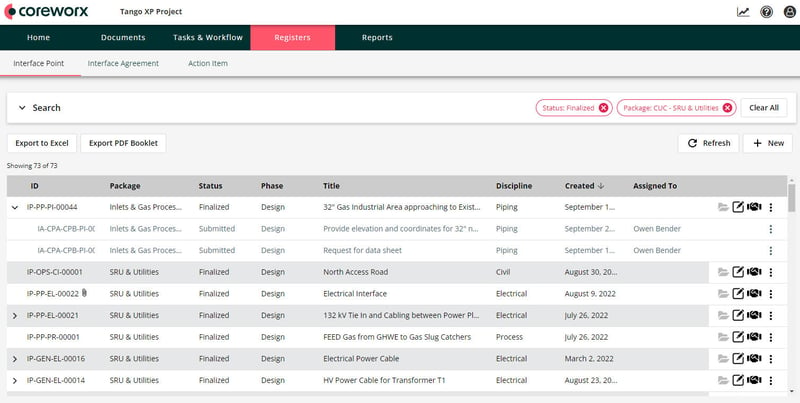
Figure 4: Interface Register from the Interface Connect solution.
"Interfaces are typically identified by a group of experts from the project, using the project’s design documents, work breakdown structure (WBS), contract documents, project specification, etc."
-Chua and Godinot, 2006
|
|
|
|
The interface register is a key tool to define and control scope delineation, track all interfaces to completion, and ensure key stakeholders are kept informed. Defining the structure of interfaces is a key first step to a successful interface management program and can vary from project to project. The goal is to eliminate gaps and overlaps; to ensure that parties that share a common boundary understand the shared interfaces, and all while, at the same time, balancing to ensure a manageable interface register is created that does not add additional and unnecessary overhead.
Related Content
- Structuring Internal & External Interfaces on a Major Project
- How Do You Structure Project Interfaces?
Step 3 – Select a Tool
Setting up a proper interface management process supported by a purpose-built system will include additional upfront costs and resources. However, the return on investment is huge; potentially saving millions of dollars by avoiding rework, delays, and subsequent production loss.
Projects must select proven tools to manage a high volume of interfaces and their resulting complexity to ensure interface risk is managed effectively throughout the project. Although interface management software cost more than a basic spreadsheet, the value the system provide far outweighs the substantial costs historically associated with poorly managed interfaces.
Related Content – Learning from Our Mistakes: Why Interface Management is Vital to Project Success
Crucial to the success of your project is using automated interface management tools built specifically to support the interface management program designed for your project. The tool you select should support your plan, not the other way around.
With Coreworx Interface Connect interface management software, automated workflows and forms work to ensure compliance with your plan. The work processes within the system are designed to ensure the appropriate reviews/approvals are obtained. With built-in alerts and escalation, all stakeholders are kept informed. Online forms are designed to support consistency in data capture, which in turn will support the reporting and interface management KPIs you’ve designed for your project.
Supporting a web-based online interface register provides a single source of truth since all interface and delivery teams can reference and contribute to a single register. With an online register, the project team responsible for managing all interfaces is no longer required to decipher and merge multiple spreadsheets from multiple delivery teams. Global project teams can access the information anytime from anywhere.
And the data in Coreworx Interface Connect is secure. By using a robust roles-based security model, access to interface data is always controlled.
Top 5 Reasons Why You Should Use Interface Management Software
Here are the top 5 reasons why you should use the industry-leading Interface Connect solution on your project:
- Real-time reports and dashboards – Get quick access to insights that help support timely interface risk mitigation
- Schedule integration – Get insight into high-risk interfaces that may harm your overall project schedule
- Automated workflow – Ensure all contracting parties and stakeholders are compliant with your interface management process that is critical to project success
- Complete audit trail – Should conflicts arise, get quick access to detailed logs of all activities related to interfaces
- Stakeholder notifications based on RACI Matrix – Keep all stakeholders involved and informed automatically based on the responsibilities matrix defined by the project
Related Content – Advanced Project Insights with Interface KPIs
Step 4 – Communication & Training
Crucial to ensuring the success of your interface management program is providing ongoing communication and training of all stakeholders. It is important to promote clear, timely, accurate and consistent communication. This becomes even more critical when dealing with multiple contractors in many locations with different languages and cultures. Stakeholders need to know who they are expected to communication with and how.
The communication plan or strategy is a component of your Interface Management Plan. Here you document the expectations with regards to communication and collaboration.
Interface Agreements document the exchange of information and deliverables between two interface stakeholders. Deliverables can include engineering drawings, specifications, design reports and calculations, equipment details, and project schedule information.
Ensuring interface teams are communicating and sharing information needed to successfully manage interfaces will have a significant impact on the success of your program.
Facilitating regular interface meetings is another form of communication and is important to stakeholder alignment and the overall interface management program. Project teams should establish regular interface meetings between interface stakeholders. Objectives include:
- Ensure ongoing alignment of interface parties
- Resolve interface and scope issues
- Review all open issues, confirm delivery dates, and update as necessary
- Identify/document new interfaces
- Prioritize critical interfaces
Training is also essential. Not only should stakeholders be given training on the tool(s) used to support your interface management program, but they must be fully aware of and trained on the methodology to identify, manage, and resolve interfaces.
Related Content
Interface Management Software
If you're ready to align your entire team, manage communication, define and control scope delineation, track interface requests to completion, and ensure you're keeping key stakeholders informed, then it's time you used a formal interface management program, like Coreworx interface management software.
Projects worldwide have trusted our interface management solution for more than 15 years. Interface Connect equips you with the automation tools and support you need to:
- Formalize scope delineation
- Mitigate cost and schedule risks
- Improve accountability
- Ensure policy compliance
- Reduce errors and wasted time reworking
For a closer look at the benefits and results of interface management, watch this helpful webinar from the Construction Industry Institute (CII).
Results from the CII’s study revealed that teams who used a formal interface management program experienced less cost growth compared to counterparts not using a formal interface management.
To take the next step towards better interface management, see Coreworx in action! Schedule a demo today!
Managing Interfaces:
The First Mistake Most Companies Make
Not recognizing interface management as a project management practice distinct from other project management practices and understanding that it provides its own unique and valuable benefits is a big mistake still made today.
These projects often underestimate the challenges they will face, the volume of communication to be managed, and the risk a single interface left unnoticed represents.
Just one poorly managed interface can easily translate into hundreds of millions of dollars lost.
Interface management is more than meets the eye. To ensure the timely exchange of information and deliverables, project teams must manage hundreds (or even thousands) of dependencies. Added to this challenge, this exchange is often between external entities with no contractual relationship, yet it is critical that they collaborate. For many projects, interface data and deliverables aren’t treated with the same level of governance as other project artifacts. For example, interface data and deliverables should be included in the project handover process at project completion, yet it is often forgotten.
Some organizations think they can manage interfaces using existing project practices, processes, and tools.
Why Managing Interfaces with Spreadsheets Is Risky
Current methods of managing interfaces through spreadsheets and email do not provide the level of control or up-to-date real-time information required. Spreadsheets were not built for interface management. Even the most sophisticated spreadsheet cannot properly document the distribution of information needed to support a large complex project.
At first glance, doing it this way may seem like the most cost-efficient approach: it doesn’t cost anything extra – spreadsheets are free, right? Wrong!
Using spreadsheets for interface management may cost you millions of dollars due to errors, lost time, and inefficiencies. Here are the many reasons spreadsheets are insufficient at managing interfaces on large, complex projects:
- Spreadsheets can be lost or corrupted. Yes, both of these have happened!
- Decisions are made using incomplete and usually outdated information
- The project team has no visibility until monthly updates are provided
- Inconsistency in the data captured for each interface
- No alerts and notifications make it difficult to ensure deliverables are received promptly
- Lack of real-time reporting and dashboards
- Zero audit trail
- No ability to enforce compliance and standards
- Lack of integration opportunities with other key project management practices
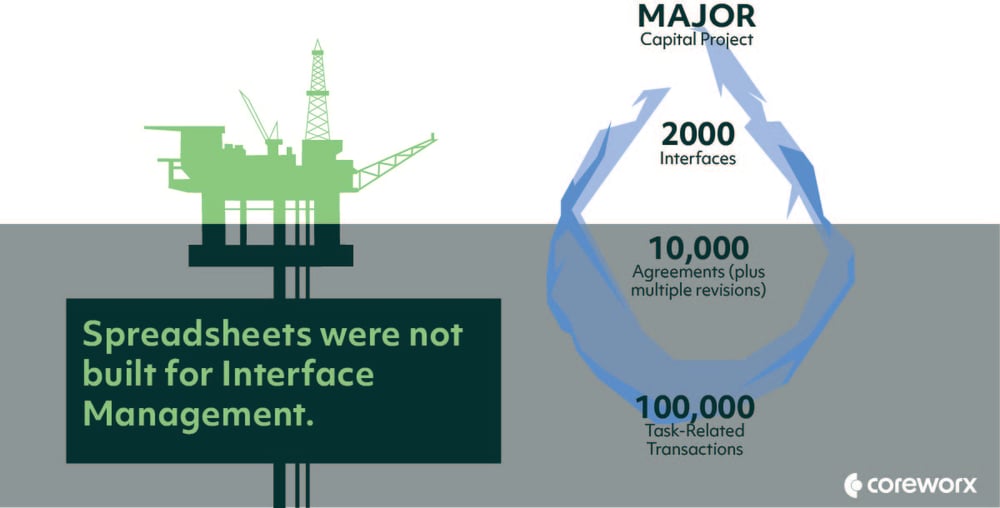
Related Content – Spreadsheets Were Not Built for Interface Management
Why Managing Interfaces with the RFI process is Risky
At first glance, these business processes seem similar. Both help manage significant risk to projects by facilitating communication and information, but each performs their own unique project-critical role.
The differences between interface management and the Request for Information (RFI) process include:
- RFIs are an unplanned, reactive process
- RFIs are not tied or related to an interface which means scope delineation is missing
- RFIs are typically raised by an external party and responded to by the project team
- RFIs have contractual response dates/timelines
Interface management provides the additional structure of defining project interfaces and ensuring the exchange of information and deliverables related to those interfaces are captured and related to the interface, giving the project team complete visibility on all activities and decisions made at a single interface. This structure is just not present with an RFI process.
Related Content – Requests for Information (RFIs) versus Interface Management for Mega Projects
Why Managing Interfaces with Document Management Systems Doesn’t Work
Document management is essential for any significant capital project. Managing the flow of documents and the engineering reviews and approvals is critical for project success. Document control ensures receipt and distribution of these engineering deliverables. In fact, many engineering documents submitted through the formal document control process are also interface deliverables.
But document management isn’t interface management. Document management systems are used to receive, track, manage, and store electronic documents; the focus is on ensuring that all stakeholders are working with the most recent document revision.
What is the missing component? Interface collaboration! Sure, emails can be stored in a document management system, but relying on emails to exchange interface information increases the risk of not keeping all interface stakeholders informed, and there is no tie-back to the actual interface. Scope delineation is not defined, which results in ambiguity on the roles and responsibilities at individual interfaces, which opens the project to interface risk.
Related Content – Resources for Capital Projects
Interface Management Case Studies
A critical consideration before purchasing software for your company is understanding if it will yield the return you’re needing.
For more information on how Coreworx Interface Connect software has helped other major capital projects stay on time and overcome hurdles, see the following case studies:
|
|
IM Helps Capital Project Finish on TimeAn oil & gas project in Northern Canada was struggling to overcome major hurdles including contractor turnover, environmental/weather factors, and reaching critical milestones. This is where Ascertra's interface management solutions stepped in to help the project reach completion on time. |
|
|
Improved Project Outcomes with Interface ManagementDue to confusion in scope requirements and mismanaged interface dependencies, the launch of an offshore energy platform went over time and budget, costing potentially hundreds of millions of dollars. With proper interface management, this project could've been kept on track. |
|
|
Modernization with Interface ManagementDuring a major oil refinery's modernization project, they realized it would bring many challenges including large volumes of high-risk interfaces and a growing, complex communication matrix, among others. Through proper interface management integration, the project was able to continue. |
"Our EPC made the recommendation and it was the right decision!"
-Kamran Heydarov











